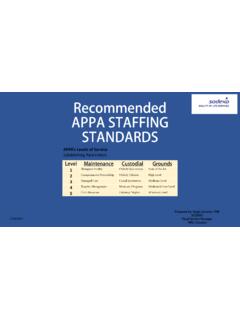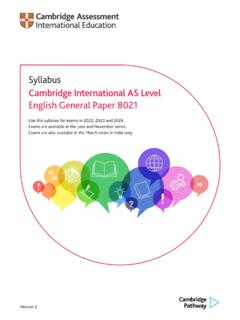Transcription of A Quick Guide to Developing Watershed Plans to Restore and ...
1 A Quick Guide toDeveloping Watershed Plans to Restore and Protect Our Waters Disclaimer This document provides guidance to states, territories, authorized tribes, local governments, Watershed organizations, and the public regarding technical tools and sources of information for Developing Watershed -based Plans to improve and protect water quality. The document refers to statutory and regulatory provisions that contain legally binding requirements. The document does not substitute for those provisions or regulations, nor is it a regulation itself. Thus, it does not impose legally binding requirements on EPA, states, territories, authorized tribes, local governments, Watershed organizations, or the public and might not apply to a particular situation based upon the circumstances. EPA, state, territory, local government, and authorized tribe decision makers retain the discretion to adopt approaches on a case-by- case basis that differ from this guidance.
2 The use of nonmandatory words like should, could, would, may, might, recommend, encourage, expect, and can in this guidance means solely that something is suggested or recommended; it does not mean that the suggestion or recommendation is legally required, that it imposes legally binding requirements, or that following the suggestion or recommendation necessarily creates an expectation of EPA approval. Interested parties are free to raise questions and objections about the appropriateness of the application of the guidance to a situation, and EPA will consider whether the recommendations in this guidance are appropriate in that situation. EPA might change this guidance in the future. A Quick Guide to Watershed Management was prepared by Tetra Tech, Inc., under a contract with EPA.
3 This Guide was developed with input from federal, state, and local Watershed practitioners and outreach experts. United States En vironmental Protection Agency Office of Wetlands, Oceans, and Watersheds Nonpoint Source Control Branch (4503T) 1200 Pennsylvania Ave., NW Washington, DC 20460 EPA 841-R-13-003 May 2013 A Quick Guide to Developing Watershed Plans to Restore and Protect Our Waters United States Environmental Protection Agency Office of Wetlands, Oceans, and Watersheds Nonpoint Source Control Branch (4503T) 1200 Pennsylvania Ave., NW Washington, DC 20460 EPA 841-R-13-003 May 2013 A Quick Guide to Developing Watershed Plans iii This page intentionally left blankiv A Quick Guide to Developing Watershed Plans Contents ii Introduction .. 1 Watershed Planning as an Overarching Management Framework.
4 1 Why a Quick Guide to Watershed Management? .. 1 Organization of the Quick Guide .. 1 Audience for the Quick Guide .. 2 SECTION I: THE BASICS .. 3 Understanding the nine Minimum Elements of Watershed -Based Plans .. 5 Steps to Effective Watershed Management .. 6 Step 1. Build Partnerships .. 6 Identify Key Stakeholders .. 6 Identify Issues of Concern .. 7 Set Preliminary Goals .. 7 Develop Preliminary Indicators .. 7 Conduct Public Outreach .. 8 Step 2. Characterize the Watershed .. 8 Gather Existing Data and Create a Watershed Inventory .. 8 Identify Data Gaps and Collect Additional Data if Necessary .. 9 Analyze Data .. 9 Step 3. Set Goals and Identify Solutions .. 11 Set Overall Goals and Management Objectives .. 11 Develop Indicators/Targets .. 12 Determine Load Reductions Needed.
5 13 Identify Management Practices to Achieve Goals .. 13 Step 4. Design an Implementation Program .. 14 Develop an Implementation Schedule .. 14 Milestones .. 14 Benchmarks to Measure Progress .. 15 Monitoring Program .. 15 Information/Education Component .. 16 A Quick Guide to Developing Watershed Plans v Evaluation Process .. 16 Identify Technical and Financial Assistance .. 17 Keys to Successful Implementation .. 17 Step 5: Implement the Watershed 19 Prepare Work Plans .. 19 Implement Management Strategies .. 19 Conduct Monitoring .. 19 Analyze Your Data .. 20 Conduct Information/Education Activities .. 20 Share Results .. 20 Step 6. Measure Progress and Make Adjustments .. 21 Track Progress .. 22 Make Adjustments .. 22 SECTION II: WHAT S NEW? .. 23 Data Access Tools .. 23 The Water Quality Portal.
6 23 Nitrogen and Phosphorus Pollution Data Access Tool .. 24 Prioritizing Sites for Watershed Restoration and Protection .. 24 The Recovery Potential Screening Tool .. 24 Promoting Healthy Watersheds .. 25 EPA Region 5 Wetlands Supplement .. 25 Lessons Learned .. 26 Nonpoint Source Pollution Success Stories .. 26 Lessons Learned from Agricultural Conservation Projects .. 26 Funding Sources .. 27 Financial Assistance for Conservation Practices .. 27 Climate Change .. 27 Adapting to Climate Change .. 27 Evaluating Climate Risks and Adaptation Options for Water and Wastewater Utilities .. 28 Emerging 28 Incorporating Social Indicators into Watershed Plans .. 28 Assessing the Value of Ecosystems .. 29 vi A Quick Guide to Developing Watershed Plans Using Green Infrastructure Practices to Achieve Sustainability.
7 29 Training and Social Media Tools .. 30 Watershed Academy Webcasts and Online Training Modules .. 30 Watershed Central .. 30 APPENDIX .. 31 Regional, Tribal, and State Nonpoint Source Program Contacts .. 31 References .. 31 A Quick Guide to Developing Watershed Plans vii This page intentionally left blankviii A Quick Guide to Developing Watershed Plans Introduction Watershed Planning as an Overarching Management Framework The Environmental Protection Agency (EPA) has for many years encouraged states and others to develop Watershed Plans to help protect and Restore our waters. Due to the complex and diffuse nature of nonpoint source pollution, the substantial costs to address it, and frequent reliance on voluntary action by individual landowners, successfully addressing nonpoint source pollution to achieve water quality standards often requires years of support from a coalition of stakeholders, programs, and funding sources.
8 Watershed planning helps address water quality problems in a holistic manner by fully assessing the potential contributing causes and sources of pollution, then prioritizing restoration and protection strategies to address these problems. Why a Quick Guide to Watershed Management? In 2008 EPA published the Handbook for Developing Watershed Plans to Restore and Protect our Waters (the Hand book ) to provide users with a comprehensive resource to develop more effective Watershed Plans as a means to improve and protect the nation s water quality. The Handbook also provides guidance on how to incorporate the nine minimum elements from the Clean Water Act s ection 319 Nonpoint Source Program s funding guidelines into the Watershed plan development process. Since the Handbook was issued, EPA and other entities have stepped up Watershed plan implementation, introduced new initiatives, developed new tools, and provided additional funding sources.
9 Over the past 5 years, thousands of copies of the Handbook have been printed. The Handbook has been used by Watershed practitioners, incorporated into training courses, and even adopted as part of college curricula. The purpose of this Quick Guide , developed in response to feedback on the length and complexity of the Handbook, is to provide a streamlined, easy-to-read summary of the Handbook. The Guide also incorporates key Watershed -related topics not included in the Handbook. The Quick Guide is not meant to replace the Handbook, but rather to provide a brief Guide to Watershed planning and highlight new information that can be used for more effective decision-making leading to improved management of our water resources. Use the following icons to help locate specific information in the Quick Guide Indicates where one of the nine minimum elements is discussed.
10 Indicates a c ase study that highlights the use of the nine minimum elements in Watershed Plans . Refers the reader to specific sections in the Handbook for more detailed information. Organization of the Quick Guide The Quick G uide is divided into two sections: Section I: The Basics provides a streamlined summary of the Handbook. It includes the majorsteps in the Watershed planning process and a brief overview of the nine minimum elements tobe included in Watershed Plans under EPA s Clean Water Act section 319 Nonpoint SourceProgram. Section II: What s New highlights recent EPA Watershed -related initiatives and presents newtools that practitioners can access to improve water quality across the Quick Guide to Developing Watershed Plans 1 If you are new to Watershed management as a planning framework and the nine minimum elements, start with Section I.
















